Batteries and chargers: information and purchase advice
Today, the energy supply by chargeable batteries or a charger is indispensable for the use of many electronical small appliances. No matter if it is a mobile phone, remote control, a high-tech torch, MP3-player or camera, all depend on the mobile storage battery. Conventionally, some more or less good but also more or less expensive devices have been applied for these purposes. In this concern, it is not surprising that meanwhile, a quite sophisticated technology of rechargeable small batteries (so-called accumulators = accummulating electrical energy) developed that are increasingly gaining a foot on the market.
Compared to the standard batteries they primarily offer a price and also an environmental advantage, even though their capacity is not as high as the one of the disposable batteries. The slightly higher acquisition costs are already amortized after some charging cycles and, if treaten right, up to 1000 charges are possible. Meanwhile, the nominal technological capacities rapidly increased, so that the noteworthy difference compared to the disposable batteries is decreasing.
Of course the needed acquisition for this is a charger that is to be chosen among a huge variety offered in the market. Depending on the price and the equipment, this purchase can be amortized already after a short time for the normal user. Of course, either the quality of the batteries as also the one of the charger is noticeable in the price differences; depending on the frecuency of use and the requirement, the user can and will find his "combination of dreams" in a market offer that is meanwhile as large as confusing.
Basic information concerning rechargeable batteries and chargers
Before having a deep look into some chargers and rechargeable batteries, I would like to compile some basic information about batteries and chargers, as the best batteries and chargers do not make any sense if they are not correctly applied. Those who have a little background knowledge about batteries, chargers and their features will be able to handle them better and to apply them more accurately.
Structures, types, chemical composition
The batteries can be classified into different categories; they can be sorted according to different criteria and/or distinguished from each other, on one hand by the structure, on the other hand by the type of batteries according to their chemical composition beside the battery size and the referring nominal capacity.
Meanwhile, the camera producers taylor a specially developed battery for almost each type of camera of which there are barely models of similar shape, size and capacity. Also in the case of mobile phones or notebooks some batteries are applied that are specially designed for the respective device. Differently to the peripherals as the clip-on flashes or the remote releasers, GPS-devices or torchs: here, the usual sizes as AAA (micro LR03), AA (mignon LR06), C (baby LR14) and D (mono LR20) are applied.
The bigger the battery, the more capacity it usually has. As meanwhile the former nickel-cadmium (NcCad) batteries are forbidden in Europe, primarily the lithium-ion (Li-ion) batteries are applied that are meanwhile the most used ones as also the nickel-metal hydride (Ni-MH) batteries are. The nickel-metal hydride cells are meanwhile more or less cheap and due to this reason they are mainly applied in the standard sizes of the batteries. As in the case of the lithium-ions, the energy density is higher, they are specially used in the small devices that have to be light and require a long operation time (specially adapted batteries e.g. for mobile phones, notebooks or cameras).
Memory effect
Unfortunately, the misbelief is widely spread that the modern batteries (specially the nickel metal-hydrid NiMH) do not have any memory effect any more and/or that all modern chargers can avoid it. Actually, the tendency of this is a decrease in the technological development, but it is still existent, a thing that makes a charger lose in durability and capacity sooner as wanted due to the wrong handling of the charger or lack of knowledge concerning the charger and the possibilities it offers.
The memory effect is when a charger starts to "remember" that only a part of its capacity has been used because it had been loaded much too early (re-loaded) or it had not been loaded completely. If this happens only once or a few times, the charger will tolerate this of course, but the proper loading is essential for the capacity and the durability of the device.
Even though most of the devices do recognize a defective charger or the wrong polarity, one should in any case pay attention to position the batteries in the correct direction. Most of the chargers do - as far as their possibilities allow it - automatically the right thing with the battery, but the user unfortunately does not. Although the modern and specially the Ni-MH standard batteries that are meanwhile in common use do have a less pronounced memory effect (in case of this type it is correctly spoken of a - similarly natured - "lazy-battery-effect"), the battery maintenance should be taken seriously and one should take care of a correct loading (in the right stage of discharge), as far as this is not done by an intelligent charger. By the way, in the case of the lithium-ion batteries there is no memory effect known. One basically has to assume clearly that every battery - no matter which type - loses capacity in the course of its lifetime and will be over-used (see for example car battery).
Deep discharge
A problem that should not be less estimated is the excessive discharge up to the so-called deep discharge, a thing that damages the battery seriously, takes away almost all of its capacity and that can be only readjusted with some special preparations or devices. It is, for example, absolutely senseless to use some recharcheable batteries for some appliances of low consumption as for example for a wall clock, a LCD display ( e.g. clock, thermometre) or a remote control. These items do need such a small quantity of energy, that the chargeable batteries are over-used to such an extent that they get "emptier than empty".
To the contrary, if the rechargeable battery is fully used with a normal (high energy-consuming) device (e.g. camera, torch, flash unit), a normal discharge takes place and the chargeable battery is discharged in an optimal way for the recharging. This is managed automatically as most of the times, the devices turn off by themselves or do not work anymore if there are not enough reserves in the energy dispensers. Regarding the perfect charging process, the modern and specially the more expensive chargers offer an automatical recognition of the remaining capacity and an eventual automatic refresh function: If necessary, the batteries are discharged up to an optimal level and is not reloaded as usual up to then.
Alternatively, there is a basic possibility to discharche the batteries "manually" to the optimal state of discharge. It is surely completely wrong to simply reload some batteries that are out of use since a longer time period or some that are half discharged (provided the charger is not an intelligent device) without discharging them previously. By this way, the only right way to reload the simple chargers is to get them first emptied by a nomal consuming device as for example a torch, a video light or during a long telephone conversation in order to start rechaging them afterwards.
Charging
Which is the charging current that should be used for loading a battery? As a rule of thumb for a proper charging, 10% of the value of the nominal capacity is to be applied. Thus, if one has a rechargeable battery of 2000mAh, it should be charged with 200mA. In the optimal case, the charging time takes 10 hours (200mA x 10h = 2000mAh); but in practice, the charging times of 120%, thus 12 hours had been prooven. Of course, these are only theorical and optimal values and self-evidently, the priority is the wish of the consumer and user to get the batteries recharged as soon as possible.Depending on the device's capacity, these charging performances are differently high.
There is also to consider that in case of many devices, a maximum performance is determined for any charging-shaft that is divided by the respective number of batteries. Thus, charging four batteries can take much longer than charging only one. Fast chargers work with some higher currents, partly also with pulse charging that is considered to be more gentle to the battery. Anyway, a slowlier charging that is adapted to the capacity is basically preferrable, as the fast chargers cannot really "refill" the batteries in such a short time.
Another aspect is the heat generated during the charging: The cooler the battery remains, the less it will be damaged. The fast chargers partly have an additional fan in order to avoid that the temperature goes up uncontrollably. Thus, those who approach the topic of charging and its therory with intelligence and skill will be well off with a more simple charger as long as the charging times and charging currents are respected. Those who need or want to charge their batteries in a fast and easy way will use a more sophisticated device that practically works automatically.
Chargers for standard batteries of Braun Photo Technik
The standard batteries are used in almost all households. Typically, they are applied in fixed line telephones, kitchenscales or torches. But also for many special devices, the standard batteries are sufficient, as for example the flash units for the cameras, video lamps, MP3-players, navigators, light panels or digital image frames.
The chargers for the standard batteries are available in many hypermarkets already for a price below 10 €; but there are also chargers at a three-digit euro price. In the following we will present you some chargers for standard batteries of different price categories. By comparing each of the products it gets clear in which functions the cheap ones differ from the more expensive models.
Braun Compact Charger 2000
This small and handy device is designed for the occasional user and does not have any features. It is a so-called plug charger, which means it does not have any cable and the device itself is plugged in. It has a capacity for two batteries and it can be delivered in two different variants, one is including 2 mignon cells - AA (NiMH) with 2700 mAh, the other is including 2 micro cells - AAA (NiMH) with 1000 mAh.
The handling is easy: put the batteries in, plug in the device and the charging already starts. In the interior of the device, two spring chambers provide the contact for these two different sizes of mignon and micro. The charging is recognizable due to two luminous red LED's, one for each charging shaft.
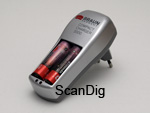
As the charging current is maintained at a quite low level, the batteries sized AA (mignon) need up to 24 hours, batteries sized AAA (micro) up to 10 hours in order to be fully charged. The required charging times can be read in the instruction that are available in four languages (German, English, French, Spanish); one simply leaves the device in the plug until the values of the table are achieved. But this is to be highly respected as the device does not have any protection against overheating or overloading. But the low charging current of 100mA already provides a certain protection against the overloading in case the charging is not ended by unplugging the device or by removing the batteries. Thus, to "forget" this for an hour is not a tragedy. It is not possible to charge a mignon and a micro cell simultaneously.
The charger is very handy as it is very light (116g) and compact. Thus, it is suitable for taking it to travels into those countries with European standard plugs. What is less practical are the very long charging times; thus, those who want to quickly charge a battery will be bad off with such a device. Due to the charging time of 10 hours, one either should start the charging very early in the morning or late iun the evening in order not to have to set the alarm clock in the middle of the night for removing the charger from the plug.
Braun Professional Charger 3000
This small and compact charger has four charging shafts for the mignon-batteries (AA) plus two additional fixations for the micro batteries (AAA), which can be only charged if there are no other batteries in the charging shafts. The device has a detachable power cable with a plug of European standard and there is also an adaption cable for the plug for the cigarette lighter of the car included in the scope of delivery. Moreover, there are four NiMH - mignon-batteries with each 2700mAh included in the scope of delivery.
Depending on the applied battery capacity and number of batteries, the device charges up to two mignon batteries in approximately 3 hours and up to four mignon batteries in about 6 hours. One or the two possible micro batteries can be charged in a good hour. Here, there is also an instruction manual attached in four languages (German, English, French, Spanish) and a charging table.
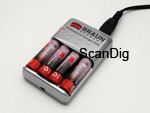
The device is microprocessor-controlled and is therewith able to recognize the defective batteries. Moreover, the charging control takes place in the form of the "Delta V" detection that is employed against overcharge. Thus, the device can remain with the batteries connected to the power supply even though there is no automatic switch to the trickle charging. By connecting the device, a green LED displays the operational readiness and, as soon as a battery is put in for charging, the charging starts that is shown by a colour change to red. Not before the end of the charging one recognizes by the LED that is getting green again that the battery has been completely charged.
The device only charges the batteries of the same type simultaneously. Due to the connection cable for the 12V on-board network in the car and a weight of only 85g (without cable) it is quite flexibly applicable. The automatic voltage adjustment for 100V up to 240V completes the package. As the device only has one status-LED for the four battery shafts, one should always put the batteries to be charged at the same time, as otherwise one does not get the information which battery is already charged and which is still charged.
Braun Professional Charger 6000
The microprocessor-controlled Braun Professional Charger 6000 is designed as a fast charger and offers several interesting features. Every charging shaft has an individual monitoring by a LED. The operational readyness is displayed in green colour until one inserts one or two batteries. Then the colour of the respective LED switches to red and the charging begins. This is noticeable by the blinking of the display of each of the charging shaft.
These short speed cameras are a synonym for the pulsed charging (instead of permanent charging), that is considered to be more gentle to the batteries and that also entails a higher charging effectivity, amongst others, because the batteries do not get so heated during the charging. But the device is only developed for NiMH-batteries, other kind of batteries cannot be put into this device. After the charging, the LED's are permanently illuminated in green and thanks to the Delta V-charge control in conjunction with the conservation of charge electronics, it is automatically switched to trickle charging.
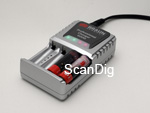
The medium charging time for standard batteries is of about 3 or 4 hours. Thus, the device can be plugged and the batteries can remain in the shaft , a thing that guarantees continuously charged batteries. What is outstanding is the automatic refresh function that recognizes the charging status of the batteries once they are inserted and decides by its own whether the batteries have to be previously discharged or if they can be charged straight away.
Another advantage is the possibility of charging different types of batteries (mignon AA and micro AAA) simulataneously. The defective batteries are recognized automatically. With a weight of only about 100g (without the cable), the device is certainly optimal for the transport, but due to the special charging technique it is rather apt for the stationary operation, as this is the only way the trickle charging persists. In the scope of delivery there are 4 NiMH-mignon-batteries (2700mAh) included as also an instruction manual in German, English, French and Spanish. The automatic voltage adjustment takes place in the range from 100V up 240V.
The Braun Professional Charger 6000 is an optimal charger for those who need some recently charged batteries on a daily basis. For example, a photographer who works in his studio with a lot of flashlight will need every day one or several freshly charged sets of batteries for his flash unit. Thanks to the trickle charging function, the Professional Charger 6000 guarantees to have always some charged batteries at one's disposal. As one usually removes the batteries from the flash unit although they are not completely emptied yet, the automatic discharge of the device provides an optimal charging procedure.
Braun Professional Charger 7000
The Braun Professional Charger 7000 is a quick charging device that is designed for the high-speed-charging. Compared to the Professional Charger 6000, it charges the batteries even faster (mignon - AA with 2000 mAh e.g. in about 40 minutes). Beside the integrated electronic overheat protection, an additional fan assures that neither the charger nor the batteries get much too hot. With the Delta V charge controller, the overcharge is discarted, and after the successful charging, the device switches over to trickle charging and this is the reason why it can be left permanently connected to the power supply with the batteries. The defective batteries are recognized and not charged and the charging of mignon- and micro batteries is simultaneously possible.
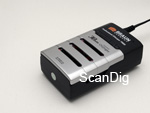
Thus, the microprocessor control has eveything under control and the user has some charged batteries within a short time. After the plugging, a peep indicates the operational readyness and the charging procedure starts immediately after the insertion of the batteries, for which the fan immediately switches on. The charging shaft is covered by a slitted lid providing the right air condition.
Some red LEDs confirm the charging procedure for each of the charging shafts, thus the charging procedure of each charging slot is independent from each other. Once a battery is charged, the device peeps three times, if all are charged, the device will peep seven times, and the LED's that now change to green indicate the completed charge. It is possible to load up to four batteries simultaneously (4xAA or 2xAA plus 2xAAA), and there are only two shafts for the micros (AAA).
The instruction manual is written in five languages (German, English, French, Spanish, Czech) that inform about the features of the device and the handling of it and an automatic voltage adjustment for 100V up to 240V completes the package. Although the charger itself only weighs 135g, the charger weighs together with the cable additional 240g. Such a high-speed charger is a very practical utensil. The charging procedure is so fast that one can practically watch how the batteries are charged. One can simply and quickly charge some batteries during the lunch break or puts some empty replacement batteries into the charger while working with the other batteries.
Braun Professional Charger 8000
Now we come to the top model amongst the standard chargers: The Braun Professional Charger 8000 offers, beside the single shaft charging by the microprocessor function, two special features: Beside a green readyness indicator, there is a LC-display per each shaft that indicates the charging status in three stages that are 50%, 75% and 100%. This is specially practical in order to verify the charging stages and/or the capacity of the charged batteries and/or those batteries to be charged.

Moreover, this device has a key with which it is possible to switch from "charge" to "discharge plus charge afterwards" (refresh). Respectively, this device guarantees the optimal automatic discharge up to the discharge status from which the batteries can and should be perfectly charged. The respective program is also displayed.
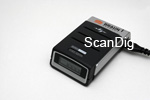
Despite the single shaft monitoring, overvoltage protection and -Delta V charging control, the status "charge" or "refresh" always applies for all shafts at once. Thus, it is not possible to, for example, to apply the refresh-function in one shaft and only charge in the remaining three ones. But therefore, it is possible to mix mignon- batteries (no matter of which capacity) in any way and order. The device recognizes defective batteries and does not include them into the charging procedure.
After the charging process, it is automatically switched to the trickle charging, which means the battery is kept full with a slight charging current. Therewith, the battery is guaranteed full by removing it from the plugged charger. After putting in the batteries, they disappear in a well aerated plastic flap. The scope of delivery includes a multilingual instruction manual (German, English, French and Czech) and a voltage adjustment within the range of 110V to 240V is a matter of course. Without the power cable, the device weighs about 140g, thus can be also applied universally. Also this device is optimally suitable for the continuous operation. Thus, those who need some charged batteries on a daily basis, will be best off with the Professional Charger 8000. One simply continuously inserts a set of batteries in the device and thanks to the automatic conservation of charge, one has always the guarantee to have charged batteries after the charging procedure.
Special chargers and universal chargers
Beside the standard chargers, Braun Phototechnik offers some special chargers equipped with some very interesting gimmicks. One of them offers the charge function for mignon- and micro batteries PLUS different NiMH- and Li-ion- special sizes due to its adjustable contact pins, another one can take almost all battery sizes of a camera producer and the following one is not only a charger but also an energy station for replacement capacity.
Braun Double Side Charger
Braun offers its sophisticated Double Side Charger for some different battery sets of the following companies: Fuji/Casio/Kodak, Canon, Sony, Nikon/Konika/Minolta, Panasonic, Olympus/Fuji and Samsung. The highlight and meaning of this charger is the use of only one device for the most common batteries of one, two, or even three camcorder- or camera producers. During the holidays in which for example one person uses a camcorder, another one carries a digital SRL and also additionally a snapshot camera in his shirt pocket, it is possible to charge all lithium-ion battery sets with one device.
The condition for this is, of course, the use of the devices of one of these producers or a convenient combination of those. With the car loading cable that is included in the scope of delivery, this device (incl. the supply unit it weighs not more than 250 gr.) is optimal for many charging possibilities on the way. The name "Double Side" means that the device has some different insertion slots at the upper and the lower side for different battery types.
Every slot is exactly marked for the right type of batteries to be charged there and only due to the design it is difficult to get confused. At both sides, there is each a transparent slide cover that on one hand protects the device against the dust and dirt, and on the other side, it makes the side that is not used during the charging procedure to function as a laying surface of the device. On both sides a LED is fixed that - also in the plugged status - first illuminates in red light when the battery is inserted and with which the charging process starts. If the LED changes to a permanent green colour, the charging process is completed. It starts to blink in green colour if it is switched to trickle charging, a thing that takes place fully automatically.
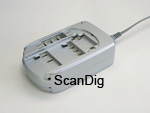
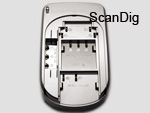
The microprocessor control provides the recognition of the type of battery and its energy technological values and adjusts the respective charging current with the voltage in the right way. The Delta V - control provides the end of charging at the right time and therewith protects the battery against overloading and overheating and damage. After the actual charging process it is automatically switched to the trickle charging. Beside the lithium-ions, also lithium-polymer batteries of 3,6 up to 7,4 V are optimally charged, a temperature sensor assures that during the charging procedure the battery is not overheated and switches the device off if needed, a thing that also happens in case the battery is inserted in the wrong polarity. Only one battery can be inserted for the charging. As it is the case of almost all Braun devices, the device automatically adapts to the voltages in the range of 100V to 240V. The short instruction manual is available in eight languages (German, English, Italian, Spanish, Greek, Czech, Russian and Polish).
The Braun Double Side Charger is a device that one will not want to miss anymore if being the owner of several cameras/camcorders of a producer. The disturbing condition of having several chargers ready for use is omitted; one simply has to have the Braun Double Side Charger handy and as soon any battery gets empty, one puts it into the respective slot. Of course, the same advantage applies during the holidays. Thus, we clearly recommend the Braun Double Side Charger to everyone who owns several cameras or camcorders.
Braun Charger 1forALL
Who does not know the annoyance of having to put a lot of chargers and cables into the suitcase while packing the holiday luggage, just because each of the electronic devices do have a certain and own type of battery? Those who take a digital camera, a separate flash unit, a camcorder, a video light, a GPS-navigator and maybe a compact digital camera to the family holidays, will need one charger for each of these devices. Therefore, there is now a simple solution that is the Braun Charger 1forALL.
This small device of a beautiful design is a device that's got the lot. It is possible to charge almost any battery with it, from the specially adapted lithium-ion battery of any size and producer up to the mignon-size (AA). The genius construction enables a continuous width adjustment that does not only capture two mignon- or also micro batteries but also releases two adjustable contact pins running into a groove. These contact pins can be slided to any width and position and therewith flexibly capture any measure of the standard li-ion and NiMH battery sets.
Beside the power supply that can be operated with voltages from 100V to 240V, also a car-loading-cable is included in the scope of delivery that completes the univesal appliance of the device. The mignon- and/or micro-batteries have to be inserted in the correct polarity, the polarity of the battery packs as also the right battery voltage (in case of NiMH normally 1,2V,in case of li-ion from 3,6V to 7,4V) are automatically recognized by the microprocessor. The defective batteries are recognized and not charged. A red LED indicates the operational readyness, a green one blinks during the charging procedure and remains permanently green once the charging is completed.
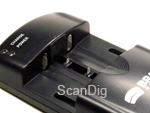
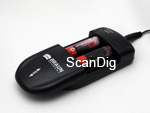
There is a contact pin added for the adjustment of the contacts that assures that the contact distance is precisely adjusted. But with subtle fingers this can be also accomplished without this tool. With the help of the instruction manual offered in seven languages (German, English, French, Spanish, Greek, Turkish and Russian), the right placement and/or the adjustment of the contacts are not a problem, the control provides the right charging of each battery and switches off automatically in case of disturbances.
With the power supply the device only weighs 152 grams, with the car-loading-cable one has, with a total weight below 200 grams, an extremely universal device that will sweeten one´s holiday. Finally, there is a charger with which one can charge all the devices one has; thus, there is no need anymore to take several chargers on holiday. Restrictively, there is to mention that for using this charger, the battery has to be removable from its respective device. For example, a MP3-player in which the battery is firmly integrated into the unit cannot be charged with the 1forALL.
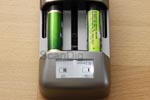
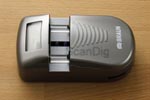
The Braun Charger 1forAll is a universal charger with which one can charge almost all batteries no matter of which type. The purchase of such a device is an investment for a lifetime. This device gets a clear recommendation from our side.
Amendment: The Braun Charger 1forAll has been such a success on the market that Braun Phototechnik introduced a successor with the Charger 1forAll Plus into the market. The Plus-version is of the same functionality concerning the charging of different types of batteries. The handling described above with two adjustable contact pins as also a slidable case are equal. But in case of Braun 1 For All Plus there is an additional display on which the exact state of charge of each inserted battery is displayed. Either in the form of a bar or as a percentage value, the state of charge of the inserted battery is displayed. Moreover, there is a numerical indication informing since when the charging procedure is taking place. The LCD-display perfectly completes the functionality of the universal device.
Braun MultiCharger BMC-50
The name is the program. But not because the charger can, as the Braun Charger 1forALL does, charge almost all types of batteries, but because this posh small case cannot only charge batteries in micro- (AAA) and mignon- (AA) size, but rather because beside the charging function it also works as a loading station. Respectively, the most important part for the user is to adjust the switcher from "Charger" to "Output".
What "Output" reveals is a very multifaceted possibility of energy supply. The first output is certainly nothing else than a normal low voltage DC plug of 5,4V with 500mA, but by means of the standard adapter pieces included in the scope of delivery PLUS the adjacent USB-plug (5V, 500mA), mobile phones (Nokia, Motorola, Sony Ericsson), iPods, several MP3/MP4 players or also games consoles (PSP, NDS) can be charged with it. The condition for this is, of course, that four batteries are inserted. If needed, the energy station also works with some standard and not rechargeable batteries.
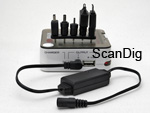
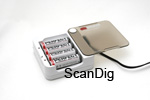
For the charging, always two batteries have to be inserted in the parallel slots. Thus, due to the double slot construction, always 4 mignon-, 2 mignon-, 4 micro-, 2 micro- or 2 mignon- plus 2 micro-batteries can be charged simultaneously. At both double slots there are always each one LED indicating the operational readyness with "green". As soon as the batteries to be charged are inserted, the LED gets red and indicates by some short flashes that the charging procedure started. At the end of the charging, the respective LED gets permanently green. The flashes during the charging procedure are due to the pulse charging and this is why the device can be denominated as a quick charging device.
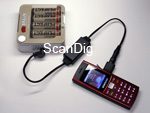
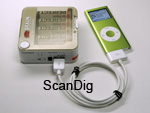
Depending on the battery capacity, the energy carriers are fully charged within a good hour (1000mAh with NiMH AAA) up to three hours (2500mAh with NiMH AA). After a full charging, the function of the trickle charging takes place. In the scope of delivery there are also 4 NiMH-mignon-cells (AA) of the Ready-To-Use (RTU) sries with 2100mAh. The device automatically adapts to the voltages from 100V up to 240V; the detailed instruction manual is available in German, French and English.
Thus, this charger can be really called a multi-charger and/or an allround-charger. If such a small device can provide energy to all portable electronic devices as handys, mp3-players, iPods, digital cameras, camcorders and accessoires, shavers and many others, it can be certainly called an allrounder.
Standard- and special batteries for digital cameras and camcorders
As a full range supplier in the field of photographic equipment, Braun Phototechnik offers, beside standard batteries and the usual standard battery types, also some special batteries for almost all standard digital cameras and camcorders to reasonable prices.
Braun standard-batteries
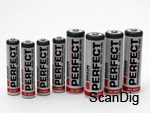
In the field of the generally known standard batteries, Braun Phototechnik shows off with an innovation: The newly developed PERFECT Ready-To-USE-batteries are certainly considered as totally "normal" nickel-metal-hydrid batteries, but due to a sophisticated development and a technological-chemical mix, they are, contrary to the usual batteries, immediately ready for use. Due to their special production technology, these batteries already are fully charged in the moment of production and even after six months, 80% of this charge remains.
This is very practical, as they are unpacked as disposable batteries and can be immediately used. Who doesn't know the annoyance of buying an electronical device and straight away some additional chargeable batteries and then have to wait with starting the device one day until the batteries are charged. Not everyone has such patience, and then it is great if the newly acquired chargeable batteries can be put straight away into the device in oder to start it immediately. Otherwise, the ready-to-use-batteries are as rechargeable as any other rechargeable batteries. They are available in the sizes mignon (AA) and micro (AAA) in a set of four pieces or in the scope of delivery (then as mignon, AA) of the above mentioned MultiCharger BMC-50.
Braun special batteries for digital cameras and camcorders
Another interesting offer of Braun Phototechnik is the almost vast offer of replacement- and rechargeable batteries of all sizes and capacities for almost every original producer battery set. A second battery is part of every standard equipment of every digital photographer, no matter if he is on the way with a high-quality SLR of with a simple compact camera.
Finally, it is much too annoying to be on the way and have to interrupt photographing because the batteries get weak, a thing that happens specially quick in the case of compact cameras, by using a lot of flashlight and keeping on the display. Those who purchase an original replacement battery of the camera producer in a specialised photography shop will be many times killed by the price. It is not unusual to pay 50 € or more for an original battery. The batteries also have a limited lifetime; those who frequently use their digital camera and need a replacement battery after some years will have to decide many times if buying a new battery or a new camera straight away.
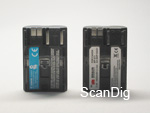
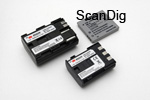
Many battery producers as the company Braun Phototechnik have recognized this grievance and offer some battery sets for almost each digital camera and almost each camcorder. Thanks to a very advanced battery production technology, the capacity values of the original are easily met and many times also outperformed. Many times, the prices are below 50% of the one of the battery offered by the original producer. Additionally, there is also a guarantee of three years offered, thus also many times a longer period than offered by the camera producer, and 3 years are a really long time period for the lifetime of a standard digital camera/camcorder.
There is a clear recdommendation from our side for the batteries for the digital cameras/video cameras of the same or a bigger capacity as the batteries of the original producer that are delivered with a guarantee of three years and that cost less than 50% of the price of the original battery. Under such circumstances, one preferrably purchases two of such replacement batteries by purchasing the digital camera instead of buying a second original battery.
Back to the index hardware tests
|